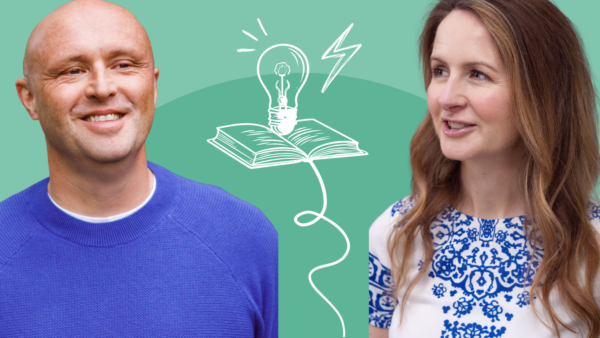Something we’re hearing from more and more organisations is how they’re looking to help their employees explore new opportunities in areas of the business that are continuing to do well even when faced with the challenges we’re seeing today. Sometimes, this kind of role sidestep might mean a need to upskill and it may well also give people an opportunity to pursue areas of strength that they haven’t yet had much access to.
So for example, there may be an opportunity to collaborate more, take on leadership or management responsibilities, to project manage, or to problem-solve, when up this point, there’s been far less availability of these kinds of tasks. So in today’s podcast, I want to consider how you can sidestep well in these ever-changing times. And the points I make won’t just be relevant to sidestepping, they’re just as relatable for people starting a new role in an entirely different organisation or industry.
My name’s Dr Paul Brewerton, the strengths guy, Founder of Strengthscope and Doctor of Organisational Psychology. I podcast first thing each week so you can get off to a strong start, with some thought-provoking tips and thoughts on life, work and strengths and how you can get the best from them all.
So onto sidestepping well and how to do it. I have five steps for you:
- know your strengths,
- work on your resilience,
- find your strength opportunities,
- take your strengths with you, and
- beware your overdrive risks.

1. Know your strengths
Before you sidestep towards your strengths, whether in your current organisation, or beyond, it’s important to get an idea of what your strengths actually are. So our strengths are those qualities that energise us and that we’re great at or have the potential to become great at. While we all have them – those qualities that mark us out as different and unique and where we can contribute to our best, most people don’t realise or acknowledge their strengths, choosing instead to focus on developing out weaker areas in the hope that this way lies success.
Well, it doesn’t, that way lies “not failure”, and that’s not the same thing as success or enjoyment or fulfilment. And with times as they are, there’s likely to be even greater risk of this negativity bias creeping in to your thinking as you focus on survival rather than “thrival”.
Knowing your strengths will help you both to not fail and to enjoy your success by focusing you on those things that naturally energise and motivate you and which you are already likely to be skilled at. So how do you get to know your strengths? Completing Strengthscope would be an amazing first step (other strength assessment systems are available), but if not, you could ask others what they value you most for in terms of what you do and how you do it. That will probably give you a sense of your strengths areas.
There’s a nice reflection exercise we often use at Strengthscope where you think about when you were last at your best, enjoying what you were doing, where things really flowed and you got good results. Then think about what strengths you might have been using when you were in that state, and you’ll get a starter for 10 on your most likely areas of strength.
2. Start working on your resilience
Secondly, during times of change, even when that change is a positive one that maybe even you have chosen and which will help you use your strengths all the more, change is change and for most humans, can invoke survival instincts which you may experience as stress. Have a listen to my podcast at Season 7 episode 4 on managing stress and change positively as well as my podcast at Season 8, episode 2 on the four things you need to do to build resilience for more on these topics.
But in the context of sidestepping, it’s important to remember to be kind to yourself, control your controllables and make sure you have a strong support network around you when facing into change, even before that change happens. That will give you a super boost of resilience just when you need it. And if you’re going to need to upskill to get that opportunity you’re looking for, you’ll no doubt need a strong slug of resilience from time to time.
3. Find the opportunities that may be there for your strengths
Those opportunities could be in your current organisation, or outside; they might even be within your current role or team if you look through a strengths lens and think laterally about what might be there for you. Once you know your strengths, you can start a one-human publicity campaign (multi-person if you bring colleagues and friends into your search) to get the message out that you have these particular strengths and that they can bring significant benefit to the workplace if you’re given more opportunity to use them.
As I mentioned, more and more of the organisations we work with at Strengthscope are waking up to the fact that only certain parts of a business or organisation can provide role and experience opportunities right now thanks to the economic challenges we’re facing, so some of them are actively encouraging employees with the right strengths (with or without the right skills…skills can always be learned) to move towards the growth areas of the business. But in most organisations, it will remain the case that you’ll have to go looking, and push yourself to the front of the queue when you find something.
Empowered with new knowledge about your strengths and the value they can create, you’re in a good position to find roles, projects or other opportunities that will help you use those strengths to their best effect, as well as communicating to decision-makers that you’re a strong candidate to consider.
4. Take your strengths with you
Your strengths are your anchor, they’re you at your best, they’re your brand, what you’re known for. So remember to value your strengths and take them with you into any sidestep role or opportunity you find from day one. I encourage you to do the work to establish when your strengths are at their best so that you can take confidence in moving into new territory that you have got this, because your strengths will make sure that you stay energised and effective in any new and changing context.
For me, for example, I can plan to use my leading, empathy and collaboration strengths in a new role in very specific and energising ways for me. My empathy strength to understand my new colleagues and key stakeholders really well – their needs and wants and concerns. My leading strength to get a new team or group engaged around a clear goal or mission. And my collaboration strength to make sure I find common ground with my team and my key stakeholders so that we can all get what we want and deliver results together.
5. Beware your overdrive risks
My last tip is to watch out for overdrive risks in a new situation. When we’re under increased pressure, particularly when we start a new role, or even start to think about leaving an old one, the extra stress we might feel can have the adverse effect of tipping our greatest, strongest qualities into ‘overdrive’ territory where they go to supercharged “OTT mode” and don’t serve us or others as well as they might.
For myself, for example, my empathy strength in overdrive in a new role might lead me to get overly concerned to fulfil the needs of others without paying enough attention to my own. My leading strength might get a bit over-zealous and feel like I’m driving my team in a direction they’ve not bought into or are comfortable with. Or my collaboration strength might get sucked into only one or two key relationships, leading me to miss my wider stakeholder context, and the other people who are keen to collaborate with me.
Do watch out for overdrive risks as these can lead to the wrong first impressions when you sidestep into a new role or opportunity.
Five top tips then to sidestep well – know your strengths; work on your resilience; find your strength opportunities; take your strengths with you; and beware your overdrive risks. It’s never too early to start thinking about what might be next for you and what you can do to get playing to your strengths even more.
This podcast is available on all major podcast platforms. Find it on Apple podcasts, Spotify, Google podcasts, Stitcher, ACast, TuneIn, Breaker and Soundcloud. Make sure to check out the back catalogue and subscribe to get them at the start of the working week!












